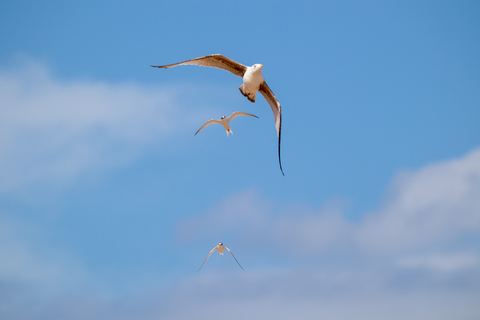It’s been very busy at the Seaton Carew little tern colony since Derek reported on their arrival. I will pick up where he left off: the majority of the returning little terns had mated, scraped their nests and settled in the protection of the fenced site. However, two little tern pairs wanted more private accommodation away from the rest of the colony and decided to nest to the north of the site in the area that becomes most crowded with people! An interesting and somewhat precarious choice! We have done our best to protect these rebels by cordoning off their nest area. A ringed plover pair joined them in this rebellion and decided to nest alone close by and have, against all the odds, just had chicks. If you visit the beach please keep back from this coned off area, as well as the fenced site.
The little terns have been showing themselves to be plucky little birds that are fiercely defensive to protect their young. It has been incredible to watch how they will take on any large herring gull that dare to fly over their nest site! These gulls can be up to thirty times the weight of the little tern and three times the length! Just one little tern will harass a gull with its fearless gutsy moves of dive bombing, chasing them off in flight and pecking at them. Way to go! Little terns usually join in helping each other show the gull whose bit of beach this is! This is a frequent occurrence at the site and the little terns are doing a great job, with the gulls getting slim chance of landing in the site, let alone predating their eggs and chicks.
The little terns have another predator that is causing them bother this year, Mr Fox and his family! Following identification of fox prints at the site prompt action was taken by our Little Tern Hero, Derek, and a night shift team commenced, with two new wardens added to the team. The persistent effort of the night shift team has been very effective at scaring the foxes back from the site, with the use of light. This action was just in time, as just a few days after the night shift commenced I spotted our first little tern chicks! What a wonderful moment this was to see those sandy speckled balls of fluff emerge from under the safety and warmth of their brooding parent. After spotting the first chick the excitement continued and we spotted a total of five! One pair having three chicks, this is good going as their clutch of eggs usually only has a maximum of three eggs.
After just three days of being brooded in the nest the chicks leave to find their own cover. This makes spotting them even harder as they are so well camouflaged in the sand, stones and vegetation. These initial five chicks are now much bigger in size than the more recently hatched ones. Little tern chicks have the fastest growth rate of all the terns and will be at adult weight around 20 days old.
We still have many incubating adults waiting for their eggs to hatch, some of these will be into their second clutch of eggs, having lost the first to the foxes. These birds don’t give up and will re-mate and have another clutch of eggs until they are successful at having chicks, providing their is sufficient time left for them to fledge before September.
An extra threat facing our colony this year is avian flu, which has been causing dead seabirds to wash up on our shores. As well as respecting the little tern nesting site and not disturbing the birds, another way that you can do your bit is by not touching any dead birds that you find on the coast.
We are grateful to Hartlepool Council for supporting the project and providing additional posts to bolster the fencing, when needed. The SeaScapes team have also been assisting the project with organised litter picks and educational events.
Please do visit the site, have a chat with us and take a look down our telescope to see if you can spot the chicks!
We are hopeful that the combined efforts of the fearless little terns and our team of wardens and volunteers, day and night, will result in the successful fledgling of chicks and help this declining species increase its numbers. Watch this space…
The photographs in this blog were taken by Luke Stringer, Little Tern Volunteer.




